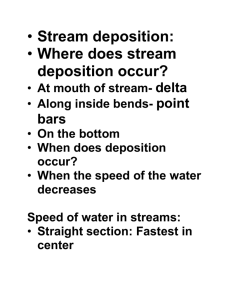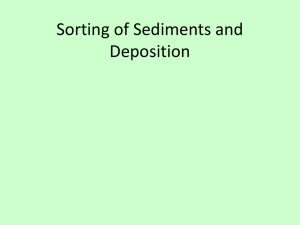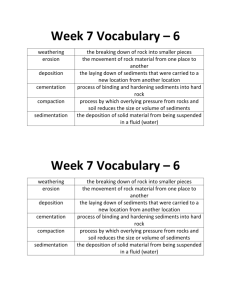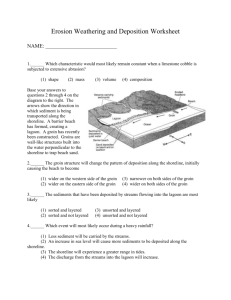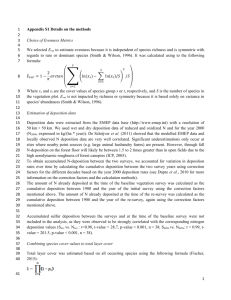TOPIC 10 – Review Book DEPOSITION Define the vocabulary 1
advertisement
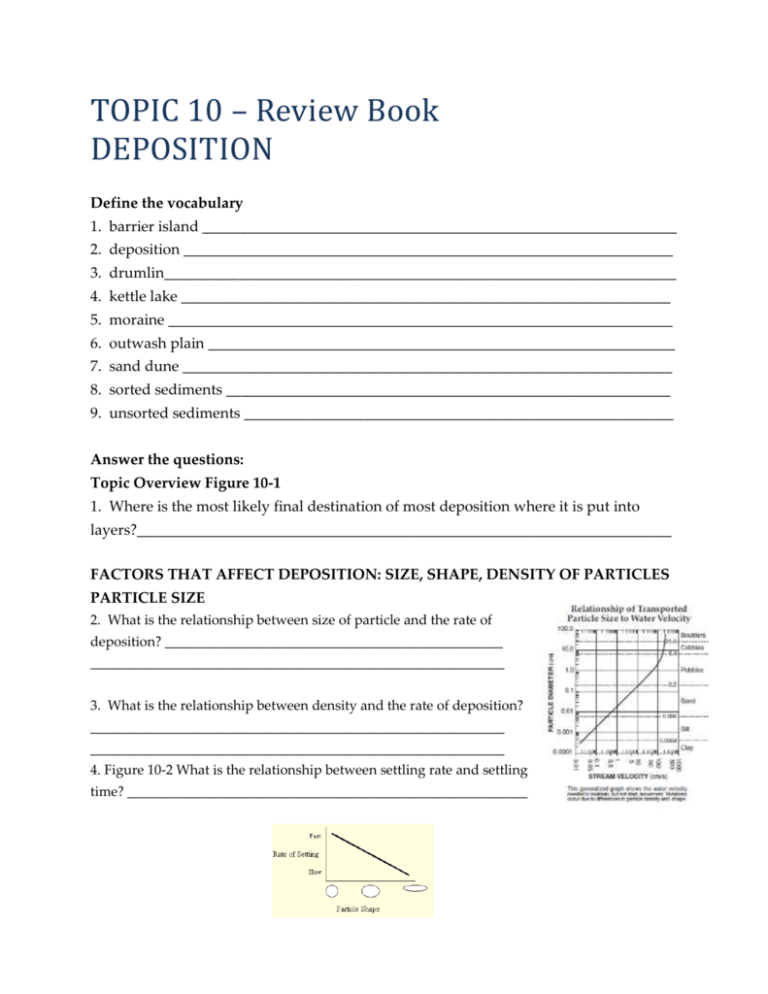
TOPIC 10 – Review Book DEPOSITION Define the vocabulary 1. barrier island _______________________________________________________________ 2. deposition _________________________________________________________________ 3. drumlin____________________________________________________________________ 4. kettle lake _________________________________________________________________ 5. moraine ___________________________________________________________________ 6. outwash plain ______________________________________________________________ 7. sand dune _________________________________________________________________ 8. sorted sediments ___________________________________________________________ 9. unsorted sediments _________________________________________________________ Answer the questions: Topic Overview Figure 10-1 1. Where is the most likely final destination of most deposition where it is put into layers?_______________________________________________________________________ FACTORS THAT AFFECT DEPOSITION: SIZE, SHAPE, DENSITY OF PARTICLES PARTICLE SIZE 2. What is the relationship between size of particle and the rate of deposition? _________________________________________________ ____________________________________________________________ 3. What is the relationship between density and the rate of deposition? ____________________________________________________________ ____________________________________________________________ 4. Figure 10-2 What is the relationship between settling rate and settling time? __________________________________________________________ SORTING OF SEDIMENTS AND DEPOSITION 5. Why does deposition happen? _______________________________________________________ _____________________________________________________________________________________ 6. What is the pattern of deposition when a stream enters a large body of water like an ocean – what gets deposited first/last? __________________________________________________________ _____________________________________________________________________________________ 7. Horizontal sorting happens when stream’s velocity slows down gradually. Vertical sorting happens when different size particles settle in calm water. Graded Bedding is a type of vertical sorting that shows several distinct periods of deposition. Using figures 10-3 and 10-4 draw the 2 different sorting arrangements. HORIZONTAL SORTING VERTICAL SORTING/GRADED BEDDING UNSORTED GLACIAL AND MASS MOVEMENT DEPOSITS – Figure 10-5 8. Explain WHY most of New York State is covered by unsorted sediment deposits.___________ _____________________________________________________________________________________ A Model of an Erosional-Depositional System Energy Transformations in the Model System 9. What is the relationship between stream velocity, slope and kinetic energy?_______________ _____________________________________________________________________________________ Erosion and Deposition in Relation to Energy Changes – THIS IS IMPORTANT! PAY SPECIAL ATTENTION TO FIGURE 10-6 TO HELP UNDERSTAND THIS! 10. Wherever the kinetic energy of the system is large, ________________ is the dominant process. 11. Wherever the kinetic energy of the system is small, ________________ is the dominant process. 12. Thus, erosion occurs in regions of ________________or high discharge, and deposition occurs in regions of ____________________or low discharge 13. Stream velocity is faster at the ____________ of curves, or meanders, and slower on the ____________ . Therefore, ________________ usually occurs at the outside of meanders and _________________ occurs at the inside. DYNAMIC EQUILIBRIUM OCCURS WHEN EROSION = DEPOSITION Characteristic Features of the Chief Depositional Agents Deposition by Streams 14. In the stream course itself sediments are deposited on the _______________ of meanders where stream velocity is ___________ . 15. What forms when a stream floods?__________________________________________________ _____________________________________________________________________________________ 16. A delta usually forms when a stream enters the ocean or a large lake. What could cause a delta not to form?_____________________________________________________________________ 17. Figure 10-7 Land Delta Looking at the cross-section – how would you describe the shape (Hint: similar to a regular delta) ___________ _________________________________________________ Deposition by Glaciers Figure 10-8 18. What forms at the edge of a glacier when there is a balance of melting and forward movement (dynamic equilibrium)? _____________________________________________________ 19. How does the shape of a drumlin tell us the direction of glacial movement?______________ _____________________________________________________________________________________ 20. How do kettle lakes form?__________________________________________________________ _____________________________________________________________________________________ 21. How does an outwash plain form and how is it different from sediments deposited directly by ice?_______________________________________________________________________________ _____________________________________________________________________________________ Deposition on Coastlines by Water Waves and Currents If after or during reading this section you realize you forgot what a long shore current is go back to Topic 9 22. Figure 10-9 How do barrier islands form?____________________________________________ ____________________________________________________________________________________ Fire Island is a barrier island located off the southern coast of Long Island Deposition by Wind 23. Why does wind generally only carry fine sediment? __________________________________________________ __________________________________________________ Figure 10-10 shows how sand dunes form. Prevailing winds are winds that blow consistently in the same direction forming a windward side which is (gentle, steep) and a leeward side which is (gentle, steep). Be able to identify the prevailing winds by using a sand dune diagram. In the diagram below the winds are blowing (right to left, left to right). 24. Figure 10-10 C – How does cross-bedding form in sand dunes? _________________________ _____________________________________________________________________________________ Deposition by Mass Movement 25. What are the three general characteristics of sediments deposited by mass movements (avalanches, rock falls, landslides, etc…)?________________________________________________ ____________________________________________________________________________________
